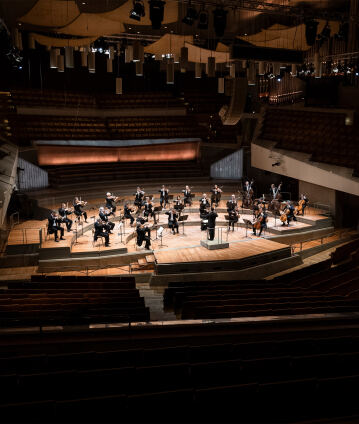The Berlin Phil Series: Kirill Petrenko live – Serenades

Mozart’s wind serenade “Gran Partita” and Dvořák’s Serenade for Strings combine youthful temperament and compositional maturity, chamber music intimacy with sonorousness and the amusing character of the serenade tradition with the musical weight of symphonic conception. Kirill Petrenko included both works in the programme for this concert of the Berlin Phil Series with members of the Berliner Philharmoniker. With this serenade concert, Kirill Petrenko also concluded his first season as chief conductor of the orchestra.
In this programme of the Berlin Phil Series, 12 wind players and more than 20 strings of the Berliner Philharmoniker performed under the direction of chief conductor Kirill Petrenko – despite the corona restrictions. This was only possible because the two instrumental groups did not play together but in two concert halves one after the other. This meant that a substantial part of the orchestra gathered in the main auditorium of the Philharmonie.
Mozart’s serenade for winds and double bass “Gran Partita” is in the tradition of Harmonie music. The wind ensemble this term describes was particularly popular in Vienna between the 1770s and 1820s. Arrangements of operas were especially in demand; Mozart himself wrote a version of his Entführung aus dem Serail for this instrumental formation. The volume which the relatively few members of the ensemble were able to achieve made this Harmonie music ideal for open-air performances. But due to its musical substance, Mozart’s composition goes far beyond the character of pure entertainment which the genre of the serenade expresses. The standard line-up of two oboes, clarinets, bassoons and horns was expanded by Mozart to include two additional horns, a double bass and two basset horns. Anton Stadler, a virtuoso of both the clarinet and the basset horn – a larger instrument of the same type – was a friend of Mozart’s. Stadler was the dedicatee of the famous Clarinet Concerto, and there is evidence that he performed four movements of the Serenade in 1784.
The work has a slow introduction, then between the first movement and the finale, Mozart placed two slow movements and minuets, and a theme with variations. The adagio is particularly famous for its melody that soars above a syncopated, pulsating rhythm, in which falling and rising lines, and narrow and wide intervals are in perfect balance.
When he was the same age at which Mozart died, Antonín Dvořák was just beginning his international career. Although he had also composed tirelessly as a young man, public performances of his works only came once he reached the age of 30. Dvořák, who despite an initial lack of recognition always remained convinced of his destiny, previously made a modest living as a private tutor, organist and orchestra violist – performing in concerts under the direction of no less than Wagner, Liszt and Smetana. The Serenade for Strings in E major, first performed in 1876, was composed at a time when he was beginning to enjoy success as a composer, and his financial situation also improved thanks to the award of a state scholarship. The largely sunny mood of the work, in which captivating lyrical passages stand alongside dance-like sections in an unmistakably Bohemian tone, may also have been inspired by Dvořák’s then recent marriage. It was works like this Serenade that not only a large part of the music public, but also Johannes Brahms – later an important patron of Dvořák’s – fell in love with.
© 2020 Berlin Phil Media GmbH
Related interviews
Artists
Our recommendations
- Kirill Petrenko conducts Schoenberg
- Kirill Petrenko conducts Zimmermann, Lutosławski and Brahms
- Kirill Petrenko and András Schiff with works by Brahms and Suk
- Kirill Petrenko conducts Tchaikovsky’s “Iolanta”
- Kirill Petrenko conducts Smetana’s “Má vlast”
- Season opening 2021: Kirill Petrenko conducts Schubert’s “Great” C major Symphony